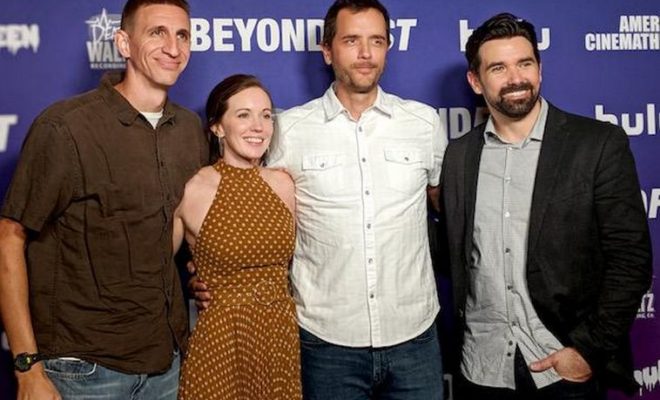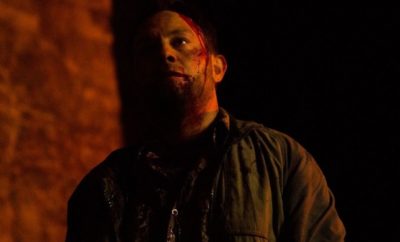 Matthew Rogers (DP), Bethany Anne Lind, Matthew Pope, Don Thompson
Matthew Rogers (DP), Bethany Anne Lind, Matthew Pope, Don Thompson
Interviews
Don Thompson & Matthew Pope – Blood on Her Name
By: Lisa Steinberg
Q) You co-wrote the film together. Where did the idea and themes we see start and how where did you begin building the script to interweave the suspense emotionally and physically that propels the premise?
Don Thompson: I think Matt [Pope] and I both have so much love for the grit and weight of the genre that we both had a strong attraction to putting something together that would let us play in that world. We’d seen so many films that lead up to someone getting killed or start there to grab the audience, then flash back to some time prior. It seemed interesting to see what would happen if we started in this intense place and let things follow from there.
Matthew Pope: Yeah, early on we were kicking around that idea of starting in the immediate aftermath of something that you don’t have any context for, but never flashing back to give all the answers and asking the audience to form and reform opinions of this character’s actions as you learn more. Someone commented that the film is more of a “whydunit” than a “whodunit” and while we didn’t think about it in those exact terms, it’s a good description for what drew us to the premise. One of the initial elements that really clicked in terms of defining the kind of story it would be emotionally was the decision to have Leigh return the body out of her sense of guilt. That helped give us a pretty good roadmap of what kinds of questions we’d be dealing with and where the emotional resonance would come from.
Q) The cinematography of the film as well is tremendously well done. It’s an amazing element that adds to the continual building tensions throughout the film. Can you talk about how this aspect helps amp up and intensify the mix of dark and thrilling themes along with the twisted interplay of force behind the character Leigh at her core?
Matthew Pope: I’m really happy with what we were able to achieve there, just knowing how limited our budget was and the challenges we’d written into it with all the night exteriors and rain work. I’ve worked a lot with cinematographer Matthew Rogers, so we had a pretty good idea of what we could pull off and what we couldn’t on our schedule and budget. We decided early on to embrace an available light aesthetic. We looked a lot at Roger Deakins’ work on films like Prisoners and Sicario, where he gives the impression of just turning on a camera and filming. We obviously couldn’t replicate the ways he did that or the tools he used, but it helped us embrace certain decisions in situations where trying to strain to achieve a bigger budget look would’ve just felt half realized. So, if we’re shooting in the woods by a lake in the dead of night, instead of trying to simulate moonlight, you just say okay, leave the car headlights on, shine them against a tree and we’ll play the scene as a silhouette against it. Let it fall to pitch black. That aesthetic helped us to not only avoid having our low budget seams show quite as much but also fit in nicely with the lived-in vibe I wanted for the movie as a whole.
Q) The film offers up a look into what propels our decisions as well as how they affect and test someone’s moral compass. What does this say about society and how we view the choices we end up forced to make for ourselves?
MP: I think “forced” is an interesting word choice there. Certainly, many of the characters in the film feel that sense of fatalism, that they’re put into situations where they may not want to make a certain decision but have no other option in order to protect the people they love. But I think one of the questions the movie is asking is whether that’s really true. I think to a certain extent there’s a relativism baked into our morality makes it increasingly easy for us to justify any actions we need to in service of our ends. All of the characters in the film, when it comes down to it, would believe in their heart of hearts that they’re really a good person just forced to do things they’d rather not do.
DT: I think one of the things I’ve always felt most drawn to in this film is looking at that blurred lines between our individual choices and the influence of the choices of those closest to us. I don’t think you can easily extract one thing from another. We all have the power to choose, but so much of how we frame that choice is inherited from a friend, a father, a mother, a sibling. We live under the gravitational influence of the people we love and they live under ours.
Q) How did working on this movie really push your boundaries as filmmakers?
MP: When you’re making a low budget indie, there’s just so little margin for error. One of the choices we made really early on in this one was to prioritize additional shooting days in the budget. Normally, a film like this might shoot for fifteen or eighteen days. We managed to get it to twenty-three, which was critically important in giving us enough time to get the performances that the film was always going to live or die by. Unfortunately, that meant that Don and I were working about a half dozen jobs each on the film, which isn’t the way I’d ever prefer to do it again. It meant not having some of the gear I would’ve loved to have to bring a bit more to the shot design. But in the end, given the same options we had this time around, I feel like we made the right decisions.
DT: Yeah, I think the shooting days were critical. If some mad person were to sit in a lab and custom design a new form of storytelling to present more challenges and hurdles to the storytellers, I doubt they could beat indie film for difficulty. It’s rewarding work, but the list of things you can’t control is at least as deep as the list of things you can. The biggest mistake you can make from the jump is planning for everything to work way you think it should.
Q) When you began filming, what were some moments you caught yourself absolutely entranced by the cast seeing how what you had written was being powerfully portrayed?
MP: Just about anything Bethany [Anne Lind] did was a joy to watch, which was frequent given that she was in every scene in the film. We wrote the script with her in mind, knowing she could carry the movie, but it’s one thing to believe it and another to look around on set after a challenging scene and see the crew enamored by her performance. In particular, I remember shooting a scene where Leigh and Richard (Will Patton) argue in the carport at Leigh’s house. It was Will’s first night on set so we were all just figuring out our rhythms together and we spent a lot longer than I normally would have just blocking out the scene and finding it together. And by the end of the scene, which is a fairly emotional scene, I remember thinking that it was a good first day for Will to be there. I’d imagined him walking onto a low budget set and having his guard up a bit about what he was in for. I don’t know if he actually felt that way or not, but after that scene together with Bethany, where both of them got to really dig in, I got the sense he felt more comfortable that what we were doing was going to be worth it.
DT: Absolutely. I don’t think there’s anything in the process more satisfying than watching an actor who knows their craft bring life to a scene. It puts a weird kind of pressure on your as a filmmaker though– like, everyone is going to know Bethany and Will were amazing. So, if this all flops we’re not going to be able to blame them.
Q) What was the most challenging aspect for you two?
MP: Getting anyone to pay attention to us, at any point during the process. I call it the “Are you making a real movie?” factor. There’s so much stuff out there that people are being bombarded with every day, whether they’re casting directors or agents or producers or sales agents or distributors. There’s no way they can give every project that comes their way even enough attention to reject it, unless it’s coming via recommendation from someone they trust or the filmmakers are already on their radars from previous work. We were constantly frustrated, not by people looking at the project and turning it down, but by people just simply never giving us the time of day. I understand why that is, because in indie film especially there’s a lot of content out there that isn’t really a “real movie” in the sense that an audience of strangers would be interested enough to pay to watch it. I get it. We had very little in the way of connections and no previous feature work as writers and directors. If they spent even fifteen minutes evaluating and considering every project with our film’s profile that came across their desks, they’d never get anything else done. But, man, if there’s nothing else this movie ends up doing, I’d love to just be able to get people to look at our next project and reject it properly!
DT: I think one of the hardest parts was the number of hats Matt and I have had to wear throughout the process. We had a bunch of amazing people work on this film, so many of whom were totally instrumental in making it what it is– we’ve already mentioned Bethany and Will and Rogers, but also our composers, sound designer, colorist, costume designer, sales agents… a few hundred people in all. But even with the people who go way above and beyond, when their job is done it’s done. It’s a little different for me and Matt. It’s more like being a parent or something. Your job is done when you’re dead.
Q) What did you learn and take away from your experiences working on this project?
MP: Never shoot exteriors in the spring in the south! I think it rained eighteen out of twenty-three days during principle. It was one of the wettest years on record in Atlanta And, of course, in the south rain doesn’t just mean rain. It means lightning. So, that timing probably wasn’t ideal.
Q) Will the film be appearing at any other upcoming festivals?
DT: We’ll still be playing international festivals. We were lucky to land domestic distribution pretty quickly (select theaters and online everywhere 02/28!), so our domestic festival run has been a little shorter.



You must be logged in to post a comment Login